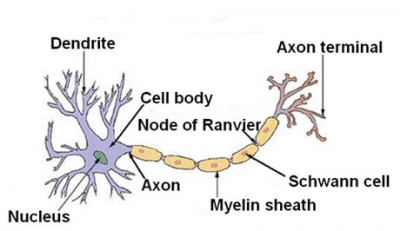
Each neuron has thousands of fibres extending from its cell body. One large fibre, called an axon, carries outgoing electrical signals, while smaller branching fibres, called dendrites, carry incoming electrical signals. The neurons connect with each other at junctions called synapses. Signals cannot jump across these tiny gaps without the help of chemicals called neurotransmitters.
Axon
An axon is a large fibre that transmits an electrical signal to the next neuron. Individual axons are microscopic in diameter – typically about one micrometre across – but may extend to macroscopic lengths.
The longest axons in the human body, for example, are those of the sciatic nerve, which run from the base of the spine to the big toe of each foot.
Dendrite
These smaller fibres receive signals from nearby neurons. The functions of dendrites are to receive signals from other neurons, to process these signals, and to transfer the information to the soma of the neuron.
Synapse
This is the junction between the axon of one neuron and the dendrite of another. Most synapses are chemical; these synapses communicate using chemical messengers. Other synapses are electrical; in these synapses, ions flow directly between cells.
Nerve cell
Each neuron has a nucleus at the centre and fibres projecting from it. Nerve cells may be described as receivers and transmitters of information that allow an organism to respond appropriately.
Picture Credit : Google

